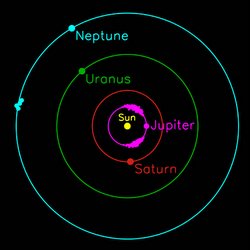The Neptune Trojans discovered so far are the fourth stable asteroid system discovered in the Solar System.

1.7.2006
By: Avi Blizovsky
Three objects locked in an orbit similar, more or less, to that of Neptune, and called Trojan asteroids, were discovered by researchers from the Carnegie Institution and the Gemini Observatory in Hilo, Hawaii. The discovery provides evidence that Neptune, like its larger cousin Jupiter, unites thick clouds of Trojan asteroids in its orbit, and these asteroids have a common origin. This brings to four the number of known Neptune Trojan asteroids.
"It's exciting to quadruple the known population of Neptune trojans," says Hubble Carnegie Fellow Scott Shepherd, who led the study that appears June 4 in the online issue of the journal Science Express. "In this process, we learned a lot, both about the way asteroids lock into stable orbits, as well as what they might be composed of, which makes the discovery particularly rewarding."
The Neptune trojans discovered so far are only the fourth stable asteroid system discovered in the solar system. The others are the main asteroid belt between Mars and Jupiter, the Jupiter Trojans and the Kuiper belt. Neptune's Trojans are hypothesized to be numerous compared to the main asteroid belt and Jupiter's Trojans, but would be difficult to observe because they are far from the Sun. To find them, the astronomers use the largest telescopes in the world, which are equipped with the most sensitive digital cameras.
Trojan asteroids cluster around one or two points that lead or trail a planet about 60 degrees on either side of the planet in its orbit around the Sun - known as Lagrange points. In these regions, the gravitational pull of the planet and the sun pushes them to lock into stable orbits that are synchronized with the planet's. German astronomer Max Wolf identified the first Jupiter Trojan in 1906, and since then more than 1,800 such asteroids have been discovered along the planet's orbit. Since Trojan asteroids share an orbit with a planet, they can help astronomers understand how planets formed and how the solar system evolved.
